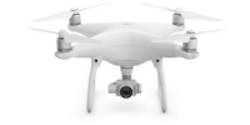Computer vision takes to the skies with Phantom 4 drone from DJI
DJI’s latestdrone, the Phantom 4, features 4K cameras and on-board vision processing to provide sense and avoid capabilities, along with automated subject tracking.
The Phantom 4 camera features 4K video capture at 30 fps and full HD 1080p at 120 fps, along with an aspherical lens with a 94° field of view, which reduces distortion by 36% and chromatic aberration by 56% when compared to a Phantom 3. A forward obstacle sensing system allows the Phantom 4 to see in 3D and to react. In normal mode, the drone will stop and hover if it sees an obstacle coming close. In TapFly, ActiveTrack, and Smart Return Home modes, it will avoid an obstacle or hover to avoid collision.
Additionally, the drone will provide warnings so that the operator always knows what is happening. A downward-facing vision positioning module contains dual cameras and dual ultrasonicsensors to offer five times more positioning accuracy than previous systems. Furthermore, if used indoors, the drone provides a GPS-like flying experience.
ActiveTrack, which provides automated subject tracking capabilities, uses a combination of computer vision, object recognition, and machine learned to track as it goes. While operating, ActiveTrack is also running obstacle avoidance, so it decides whether to continue following, avoid an obstacle, or just stop.
In a Wall Street Journal review of the drone, authorGeoffrey A. Fowler wrote that the first thing he did with the drone was fly it straight toward a tree.
"My Phantom 4 made a beeline toward a cypress, then screeched to a halt a few feet before it," he wrote. "A spider-like array of cameras built into its body can see obstacles in 3-D and make split-second decisions to pause or veer to a new flight path."
Commenting on ActiveTrack—which he noted as the drone’s coolest feature—Fowler said that it allows a user to draw a box around a moving object in the app, and the Phantom 4 will keep its camera trained on them.
"Unlike some other follow-me drones, the target doesn’t need to carry a phone or special piece of equipment," he said. "Running around a field with ActiveTrack on me, I felt like a Jedi, using the Force to either call the drone my way or make it jump back when I lunged toward it."
Read his full reviewhere.
When it comes to FAA regulations in the US, and perhaps some of the general unease felt by some people when it comes to drones, sense and avoid technology such as this should help get people get more comfortable with drones becoming more and more common.
View more information on thePhantom 4.
Share your vision-related news by contactingJames Carroll, Senior Web Editor, Vision Systems Design
To receive news like this in your inbox,click here.
Join ourLinkedIn group | Like us on Facebook | Follow us on Twitter
About the Author

James Carroll
Former VSD Editor James Carroll joined the team 2013. Carroll covered machine vision and imaging from numerous angles, including application stories, industry news, market updates, and new products. In addition to writing and editing articles, Carroll managed the Innovators Awards program and webcasts.
